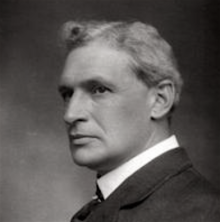
George Hubbard was born in Market Bosworth, Leicestershire, England on 19 March 1859 and was articled to Thomas Lewis Banks (1842-1920) in 1880. He later worked for him as a draughtsman and manager. He commenced independent architect in 1886 and passed his qualifying exam in 1894. The following year he was elected both an Associate of the Royal Institute of British Architects (ARIBA) and a Fellow of the Royal Institute of British Architects (FRIBA). This is possibly the only case when an architect has been elected an Associate and a Fellow of the RIBA in the same year. He was also a Fellow of the Society of Architects (FSA).
In 1898 he formed a partnership with Albert Walter Moore (1874-1965) as Hubbard & Moore. The practice had an office in London and designed houses in the Hampstead Garden Suburb for the Improved Industrial Dwellings Co. Ltd.
Hubbard was later in partnership with his son, Philip Waddington Hubbard (1893-1953), and William Charles Symes (1880-1957). He was surveyor to the Worshipful Company of Ironmongers for over twenty years, architect to Barclay's Brewery for fifteen years, and consulting architect to the City of Canterbury. He was twice Vice-President of the Royal Institute of British Architects.
Hubbard's address was given as 23 Finsbury Circus, London in 1895; 85 Gresham Street, London in 1900 and 1905; 27 West Park, Eltham, London in 1905; 112 Fenchurch Street, London in 1910 and 1920; and 45 Bond Street, London in 1923 and 1934. He died in London on 19 March 1936.
Educational: — Art School, Cambridge; Board of Extra Mural Studies, Cambridge; Dame Alice Owen's School, Islington. Factories: — 6 and 7, Bankside, Southwark (1905); factory for the Rubastic Co., Southall (1913); Croxley Mills, Hemel Hempstead (1913); factories and warehouses for James Kent in the City. Ecclesiastical: — Renovation work at St. Mary Abchurch, E.C. (1919). Domestic: — "Haslewood", King's Langley; "Britwell," Berkhamsted; "Russells, Watford; "Berkhamsted Hill", Herts; Ironmongers Almshouses. Kent; Hall Place, Shackleford, "Parkfield, Highgate: shooting lodge, Middleton-in-Teesdale; the Vicarage, Leyland, Lancs. Memorials: — Bank of India, Bishopsgate Street, E.C.; County of Shropshire, Shrewsbury; County of Montgomery; Mottlngham, Kent; Bray Church (altar rails); County of Cambridge and University, etc.; and many smaller ones. [Source: Who's Who in Architecture 1926]
______
See also Historic England; and British Listed Buildings [links below]
Directory of British Architects 1834-1914. Compiled by Antonia Brodie, et al. Volume 1: A-K. London; New York: British Architectural Library, Royal Institute of British Architects/Continuum, 2001
Gray, A. Stuart. Edwardian architecture: a biographical dictionary. London: Gerald Duckworth & Co., Ltd., 1985
‘Obituary’. The Architect & Building News vol. 145, 27 March 1936 p. 387
‘Obituary’. The Architects’ Journal vol. 83, 2 April 1936 p. 513
‘Obituary’. The Builder 27 March 1936 p. 624
‘Obituary’. Royal Institute of British Architects Journal 4 April 1936 p. 608
‘Obituary’. Royal Institute of British Architects Journal vol. 43, 9 May 1936 p. 727
Who's Who in Architecture 1926. Edited by Frederick Chatterton. London: The Architectural Press, 1926